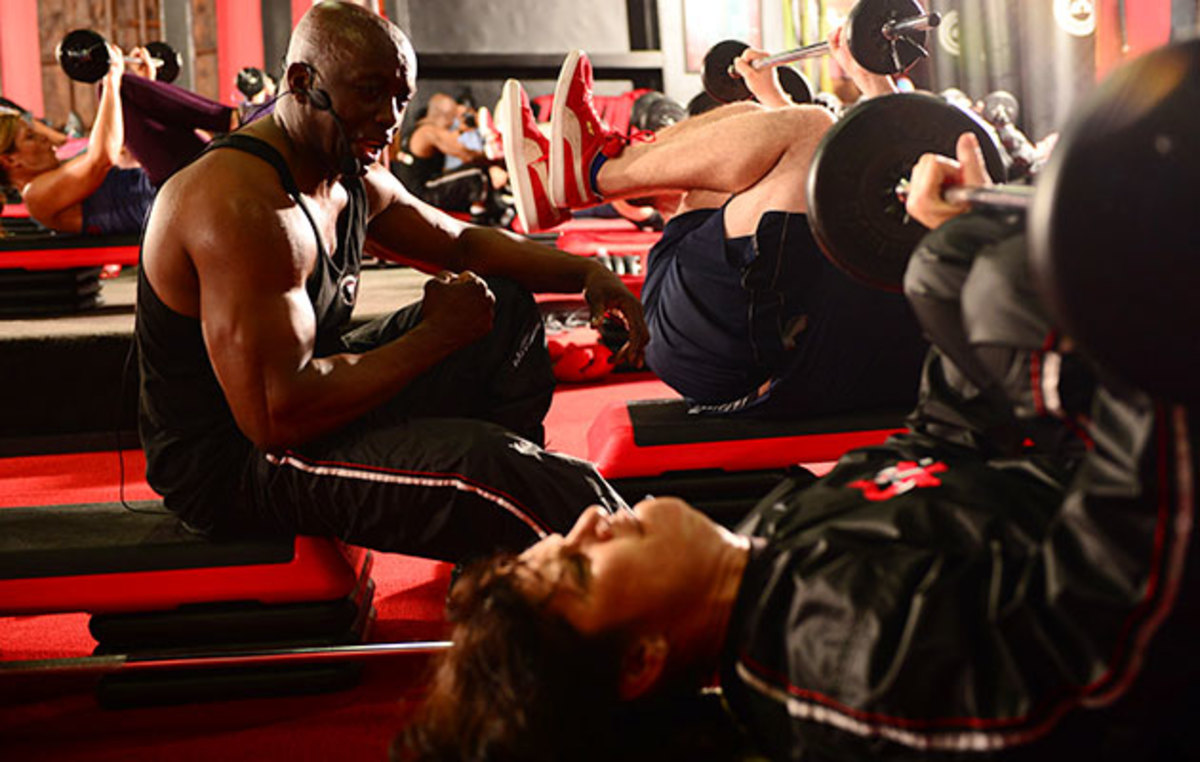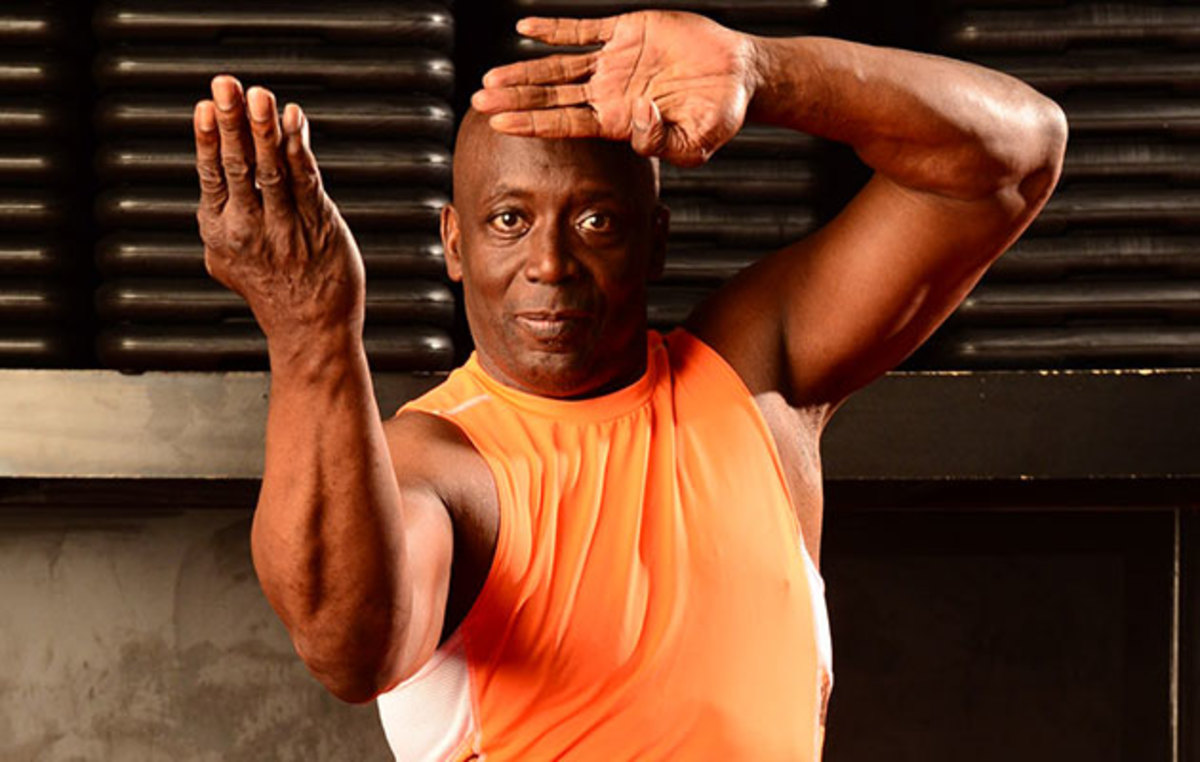Tae Bo’s creator Billy Blanks teaches to smaller audience with equal fervor

It is 7 a.m. and everyone is kinetic and beaming and dressed in leather gloves and polyester sweatsuits, awaiting the leader’s arrival.
We are in the coastal town of Dana Point, Calif., on the ground floor of a barely finished two-story rental property across the street from a liquor store. What has convened this hardy group of 15 is nothing but our fealty to fitness—not to Fitness, the state of being, but to the sweaty endeavor that will, in theory, someday get us there. A woman tells of all the inches (almost 40!) she’s dropped from her waist. A onetime pro skier says he’s shed 35 pounds since January and has never been in better shape. “Billy changed my life,” I hear several times. “It’s going to be hell,” I hear exactly once.
Running, biking, swimming, gardening (which burns 400 calories per hour, you should know, for an American male of average size)—so many ways to chase Fitness, and yet so few that call for sweatsuits.
But we wouldn’t be here if we didn’t want to follow orders. “Walk by faith, not by sight,” (2 Corinthians 5:7) is chief among them; those words, in big type, are on a sign hanging above the platform at the front of the room. Other decorations include U.S. and South Korean flags, a banner from the Golden Dragon Kung Fu society, more than a dozen mounted VHS tapes, and an old framed Subway ad, in which Billy Blanks, credited as “creator of Tae Bo, the ultimate total body workout,” holds a six-inch sub like a prize.
Tae Bo is as redolent of the late-1990s cultural moment as Jenna Elfman, Brandi Chastain’s sports bra, the federal budget surplus and, for that matter, the Subway diet. The workout came to prominence by way of late-night infomercials, promising a homespun heart-pumping hash of boxing, karate and calisthenics set to music. (Blanks invented the regimen while working out to the Rocky theme.) A passel of celebrity acolytes testified to its benefits. The target market? Women too young for Jane Fonda and too hip for Richard Simmons, who nonetheless despaired over the state of their thighs. And, boy, did it prove ripe—by May 1999, less than a year after the launch, Tae Bo tapes had grossed more than $80 million. (And to think: One major tape distributor had suggested to Blanks that white women wouldn’t buy his tapes.) He got a seven-figure book advance, cameoed on ER and spent a week on Oprah. The Parkers did a Tae Bo-themed episode. By the century’s turn, he had achieved enough ubiquity, wealth and crossover stardom to make Steven Seagal shake his fists at the sky.
But what happens when a craze curdles into a fad? Sixteen years later, what has become of Billy Blanks and Tae Bo?
• SI’s Where Are They Now issue: This year’s stories, all in one place
The workout had been encased in the cultural amber that is a Train lyric (2001’s “Drops of Jupiter”: “She checks out Mozart while she does Tae Bo/Reminds me that there’s room to grow”). The man himself, meanwhile, had the dubious privilege of appearing alongside Vince (the ShamWow guy) Offer and sub slinger Jared (pre-arrest) Fogle in 2011’s Jack and Jill, the most deplorable of Adam Sandler’s late-career comedies. In 2008, Blanks and his wife separated after 33 years together; by the next year Blanks had remarried (to Tomoko Sato, his onetime interpreter) and they had a daughter, Angelika. They were living in Japan, thriving off the local success of Billy’s Bootcamp, the successor to Tae Bo. In the U.S. he pursued moderately fruitful legal action against some of his former attorneys and accountants. Such is the indignity of being a martial arts master in late middle age.
Now he is in Orange County, the birthplace of Richard Nixon and The Offspring. After years teaching at a Gold’s Gym in Rancho Santa Margarita, he hung out his own shingle—er, vinyl banner—on Route 1 in Dana Point. And he is not done.
“My wife saw a sign saying ‘Billy Blanks Live,’” says Kyle O’Kelly, the former skier. “I said, no, it couldn’t be. I thought it’d be a video feed or something.”
But there he is. At 60, Blanks looks largely the same as he did on the infomercials. His traditional getup (a sleeveless shirt, baggy shorts and high-tops) shows off how strong he still is, despite a recent hip replacement. Now lacking the medically ballooned muscles of a bodybuilder or the cut physique of a fighter who has just made weight, Blanks is just plain big. The creases on his face just seem a little more permanent.
Shall we talk?
Not right now, he says. You’re going to take my class first.

Fitness contains multitudes, but you probably perceive its seeds in a gym, one boasting parallel rows of televisions and exercise machines, maybe even a juice bar. According to an industry trade group, the United States has more than 35,000 of them, a quadrupling over the last three decades, the business growing along with American waistlines. Planet Fitness went public in 2015; SoulCycle has announced its intention to do the same. The modern gym is sleek, faceless and offers a parade of technological perks. Mine provides an app that will interface with any hundred-dollar gizmo I can strap to my ankle or wrist.
Blanks’s pitch, his raison d’être here in 2016, is that soulless Big Fitness is doing its devotees a disservice. “What’s the difference,” he asks later, seated with Sato upstairs in a private gym, “between zombies and people doing a cardio workout? They’re mindless.” On the wireless mic Blanks is clear, telegenic and authoritative, even when improvising. When he speaks outside of class, Blanks is a little shy, even after all his success. “Why is obesity huger than ever when we have so many brand new fitness programs?” he asks, seasoning the last four words with scorn.
The less said about my performance in his challenge class the better. It was the rare workout, where a half-mile run and 100 sit-ups constituted a cool down. We punched, squatted, stepped and pumped to Justin Bieber remixes. Midway through the hour, I found myself not just dripping but spilling sweat on the mat. Was I melting? Whenever one of us (usually me) slipped behind the beat, Blanks would catch it. “Come on,” he’d bark over the mic. He’d trick us, calling out “last set” on step-ups and then asking for 20 more. “You all should know by now that I was lying!” By class’s end he had us all high-fiving in anguish and accomplishment. Drenched and gasping in his musty, no-frills gym, he had us all wanting more.
“All I do,” he says, “is make you will yourself to do things you didn’t know you could do. And then I get you to see what you just did, and then all of a sudden you start to grab a hold of it, and next thing you know, you’re on your way to doing what you need to do to help yourself.”

In April, Blanks paid a visit to FIBO, an international fitness expo in Germany. It was something of a reintroduction. He brought along the whole family: his daughter, Shellie Blanks Cimarosti, who teaches Tae Bo with her husband in Tennessee, and Billy Jr., who teaches “Dance It Out” with his wife in Sherman Oaks. “People thought I was gone because they hadn’t heard from me,” Blanks says. “But then they saw me. They started saying, ‘Billy Blanks, he’s the godfather of fitness, he’s back.’”
The godfather figures he is due some respect. Blanks believes Tae Bo is the Rosetta Stone of fitness. “What everybody’s doing now is an enhancement of, uh—well, they took it from Tae Bo,” he says. As for mixed martial arts: “If Tae Bo hadn’t come out, you probably wouldn’t have seen MMA. Dana White? He was a cardio kickboxing instructor. He took my class.” (The chronology here doesn’t quite align—UFC 1 was fought in 1993, five years before the Tae Bo tapes took off—but White really did take Blanks’s class.)
“I watch some of these athletes on TV. I say, man I wish I had 20, 30 minutes with them. I could change a lot of them.” He brings up LeBron James’s persistent cramping during the 2014 NBA Finals. “I could tell right away. I could tell by the color of his skin,” Blanks says. He thought James would be better off if he avoided sugar before games. “I had one of my managers call. ... She tried to get a message to him. But I don’t think it happened.”
It wasn’t always this way. In the early ’90s, before the tapes, before the fame, Blanks had won over more L.A. luminaries than anyone this side of Fred de Cordova. He trained Shaq, Wayne Gretzky and Magic Johnson; Brooke Shields, Carmen Electra and Goldie Hawn. After Paula Abdul spread the gospel of Blanks, the lines for his early-morning classes stretched for blocks in Sherman Oaks. The price never reached more than $15 a pop, no matter who you were. People wrote up his gym: “Billy Blanks Delivers a Punch To the Stars.”
How many fourth acts are such winners? Before the video fitness empire and the gym, Blanks had strung together a career in B movies, appearing in such fare as Low Blow, Bloodfist and King of the Kickboxers. He had done it all: built sets, choreographed fight scenes, served as bodyguard for Catherine (Daisy Duke) Bach. His movie days followed a successful run on the karate circuit. Not bad for the fourth of 15 children born to Isaac and Mabeline Blanks in Erie, Pa., one dogged in his youth not only by dyslexia but by a chronic hip injury.
Blanks has lived a life of improbable inspiration, the sort that can momentarily rinse anyone of cynicism. He tells a story, for instance, about listening to pastor Fred K.C. Price, of the Crenshaw Christian Center in South Central L.A. Price said God had told him that a congregant would bring him one million dollars. Blanks told his then wife, Gayle, “Hey, let’s give that man a million dollars.” Problem was, at the time, he had never made that much money, or anything close to it. Once the tapes had made it big, he handed Price that check for one million dollars.
Blanks is probably into act five by now, with Angelika taking taekwondo lessons from him and various new workouts debuting on YouTube. But Tae Bo remains his magnum opus. He teaches it twice a week at Billy Jr.’s studio in Sherman Oaks, and three times weekly here in Dana Point.
This time I’m watching rather than participating. The room is stuffed with two dozen women, including Sato, and one friendly man named Rino. Most of them wear Tae Bo tank tops. “One, two, count it, go,” Blanks barks, “five, six, work it, go.” For a half hour, they kick and punch in combinations, stepping forward and backward.
And the crowning flourish: the punchout. The class forms two lines, and on Blanks’s command, they scuttle ahead at an angle two-by-two, jabbing and kicking in sequence, snarling, triumphant. “Hayaku!” he calls. (It means “faster.”) They double their pace—punching, shouting, soaking. These are impassioned, empowered women, driven by a black man barking orders in Japanese, believing anything is possible. It is Donald Trump’s worst nightmare. It is Billy Blanks’s life’s work.
